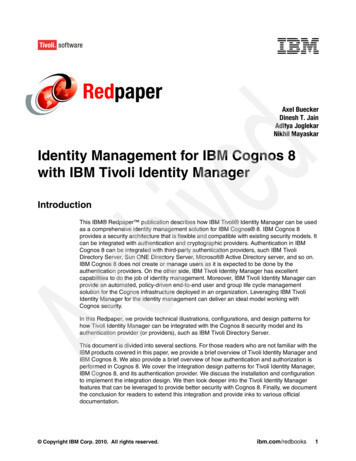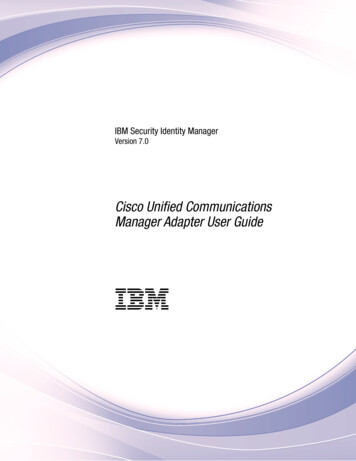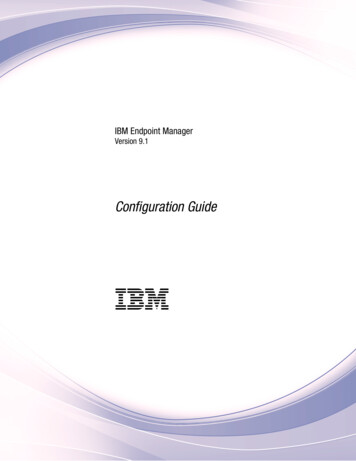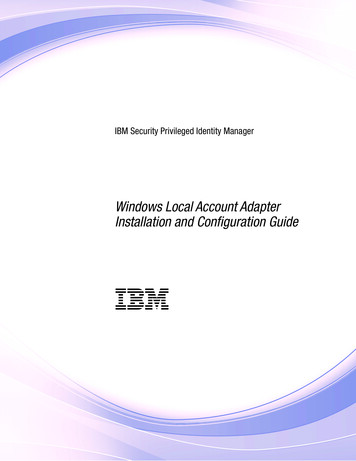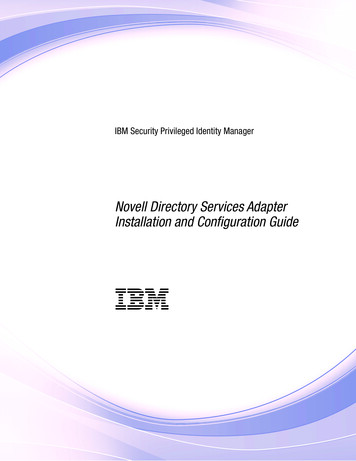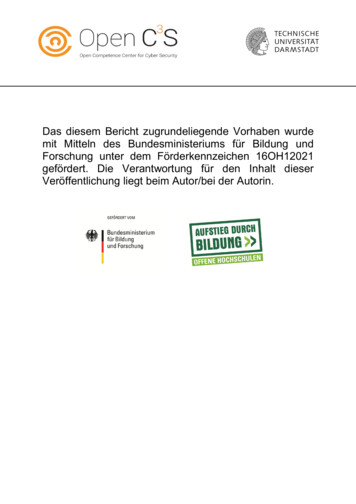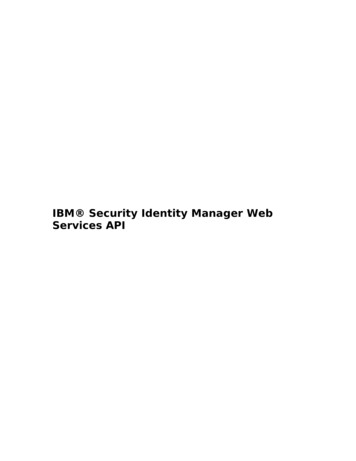
Transcription
IBM Security Identity Manager WebServices API
Table of Contents1 Introduction.52 Architecture.62.1 Architecture overview.62.2 Architecture components.63 Web Services functionality.73.1 WSSessionService.73.2 WSAccountService.93.3 WSGroupService.93.4 WSOrganizationalContainerService.103.5 WSPasswordService.103.6 WSPersonService.113.7 WSProvisioningPolicyService.133.8 WSRoleService.133.9 WSServiceService.133.10 WSSystemUserService.143.11 WSSearchDataService.143.12 WSRequestService.153.13 WSToDoService.163.14 WSAccessService.163.15 WSUnauthService.163.16 WSExtensionService.173.17 WSSharedAccessService.214 Example code to use the IBM Security Identity Manager Web Services.284.1.1 Example: Authenticate to IBM Security Identity Manager and get a sessionhandle.294.1.2 Example: Login via challenge response questions for a user (lost passwordbehavior).294.1.3 Example: Get principal person (get the person object of the logged in person).304.1.4 Example: Create person.304.1.5 Example: Modify person (including roles).314.1.6 Example: Suspend person example.314.1.7 Example: Search person example.314.1.8 Example: Search persons with an IBM Security Identity Manager account.314.1.9 Example: Get authorized services for a person (services on which a person isauthorized to have a new account).324.1.10 Example: Get principal person's roles.324.1.11 Example: Check if person is member of role.324.1.12 Example: Add role.324.1.13 Example: Remove role.324.1.14 Example: Synchronize passwords and synchronize generated password.334.1.15 Example: Add roles to person.334.1.16 Example: Remove person from roles.33
4.1.17 Example: Transfer person.334.1.18 Example: Create account.334.1.19 Example: Deprovision account.344.1.20 Example: Get account attributes.344.1.21 Example: Get account profile for service.344.1.22 Example: Get default account attributes (helpful before provisioning a newaccount).344.1.23 Example: Modify account.344.1.24 Example: Restore account.344.1.25 Example: Suspend account.344.2 Role object related tasks.354.2.1 Example: Lookup a role by its DN.354.2.2 Example: Lookup a system role (ISIM Group).354.2.3 Example: Search roles by filter.354.2.4 Example: Create static role.354.2.5 Example: Get member roles.354.2.6 Example: Update role hierarchy.354.3 Organizational Container object related tasks.364.3.1 Example: Get Organization sub-tree.364.3.2 Example: Search container by attribute.364.3.3 Example: Create container.364.3.4 Example: Remove container.364.3.5 Example: Lookup container.374.3.6 Example: Get Services.374.3.7 Example: Get Account for service.384.3.8 Example: Service search.384.3.9 Example: Get service for an account.384.3.10 Example: Create service.384.3.11 Example: Modify service.394.4 To Do task related.394.4.1 Example: Get Assignments.394.4.2 Example: Get RFI.394.4.3 Example: Get Entity detail.394.4.4 Example: Submit RFI.394.4.5 Example: Approve or Reject.404.5 Access Service related task.404.5.1 Example: Create an Access.404.5.2 Example: Get Accesses.404.5.3 Example: Remove a user Access.404.5.4 Example: search for available access entitlements.414.6 UnAuth related task.414.6.1 Example: Get challenge questions.414.6.2 Example: Lost password login reset password.414.6.3 Example: Self register.414.6.4 Example: Get self password change rules.414.6.5 Example: Extend with XML.41
5 SharedAccess related examples.436 Single Sign-On (SSO) implementation.446.1 WS-Security headers.456.2 IBM Security Access Manager (ISAM) WebSEAL HTTP headers.466.3 IBM Security Identity Manager Web Services API best practices.476.3.1 Don’t use ‘GregorianCalendar.setTime(new Date())’ for schedulingarguments .476.3.2 LDAP Attribute filter.486.3.3 Specify return attributes.48
1 IntroductionThe IBM Security Identity Manager Web Services front end is an enablementcustomization to provide a web services based channel to communicate with the IBMSecurity Identity Manager. The IBM Security Identity Manager product comes with aJava API that can be used from external applications to communicate with the IBMSecurity Identity Manager. However, it requires a Java Authentication andAuthorization Service (JAAS) configuration, and version-specific JAR files from the IBMSecurity Identity Manager application and the IBM WebSphere Application Server.The environment must be updated whenever the IBM Security Identity Manager orthe IBM WebSphere Application Server patches or upgrades are installed. The IBMSecurity Identity Manager users often ask for an easier, lightweight and Javaindependent way to communicate with the IBM Security Identity Manager.The IBM Security Identity Manager Web Services wrapper provides an easylightweight communication channel to the IBM Security Identity Manager. The WebServices client does not have the IBM Security Identity Manager or the IBMWebSphere Application Server dependency. The Web Services API exposes userfunctionality for customers to build custom applications. The Web Services API doesnot expose administration functionality. Some of the advantages of using the webservices wrapper instead of the IBM Security Identity Manager API to communicatewith the IBM Security Identity Manager are: Footprint is small. Provides a standard web services interface using HTTP/S tocommunicate with the IBM Security Identity Manager. IBM Security Identity Manager or the IBM WebSphere Application Server JARfiles in the external application are not needed. An IBM WebSphere ApplicationServer client is also not needed on the client side. No JAAS configuration needed to talk to the IBM Security Identity Manager. The IBM Security Identity Manager Web Services uses a simple data model. Aclient can generate the model and client artifacts from the Web ServicesDescription Language (WSDL) without needing any special serializers ordeserializers. The IBM Security Identity Manager API is abstracted into a functional webservices API, so client application impact is minimized during the IBM SecurityIdentity Manager or the IBM WebSphere Application Server upgrades andpatches. Additionally exposes an API to get forms data from the IBM Security IdentityManager so that a client can get data and rendering information. Form changes inthe IBM Security Identity Manager are reflected back in real time. Provides a threaded conversation capability by providing a session handle to aclient. Provides options for server or client state saving mechanisms, or a pseudostateless conversation if state cannot be saved between calls.This document describes the IBM Security Identity Manager Web Services.
2 Architecture2.1 Architecture overviewThe IBM Security Identity Manager Web Services wrapper is a suite of web servicesthat are bundled as a single web application. The IBM Security Identity Manager WebServices web application is packaged as a module of ITIM.ear and deployed as partof ITIM.ear.2.2 Architecture componentsThe IBM Security Identity Manager Web Services suite consists of: The IBM Security Identity Manager Web Services web application – bundledwith ITIM.ear file. The IBM Security Identity Manager Web Services client and data model (autogenerated by client from WSDL)The IBM Security Identity Manager Web Services wrapper is a J2EE web application.The web application contains WSDL (Web Services Description Language) files foreach web service in the suite. The WSDL files describe the web services interface andcomplex data types. You can use WSDL files while developing the Web Servicesclients.The IBM Security Identity Manager Web Services implementation is based on the IBMWebSphere Application Server JAX WS 2.1.6 runtime.
3 Web Services functionalityThe description about the web services suite functionality is as follows.NOTE: The IBM Security Identity Manager Web Services suite currently only exposesfunctionality that is required for servicing the end user IBM Security Identity Managertasks.The IBM Security Identity Manager Web Services suite consists of multiple webservices, broken up by function. The document lists all the services alphabeticallyexcept the WSSessionService because it is the first service to be called by anyapplication. The session object returned by its login method is used as a parameter inall subsequent services.The operations list of each web service is as follows.3.1 WSSessionServiceThe WSSessionService provides authentication, session creation and passwordchallenge authentication methods. This web service login method is called by a clientbefore any of the other web services are invoked. The login method returns a session(handle) object that must be passed to the other web service calls to maintain athreaded conversation. The authentication method also supports Single Sign-On(SSO) if the IBM Security Identity Manager is configured with SSO enabled. TheISIMWebServices suite has a handler that intercepts calls into the web services tocheck valid session information. It also handles session timeouts and cleanup.This service also provides a method to login through the challenge responseauthentication process in case of lost or forgotten passwords.There are two ways in which session management can be done in the ISIM webservices. Client side session management: This is the default mode. In this mode thesession management is not done on the server side. The server does notmaintain any session information of the client. The client sends the LTPAtoken to the server in every request as part of the WSSession object'sclientSession attribute. The server then constructs the subject from theclientSession parameter and validates the user. In this scenario there is nosupport for logout API. The client has to take the responsibility of discardingthe session. Server side session management: In this mode the sessions are cached onthe server side and logout is a valid API.The property enrole.webServices.session.mgmt.clientSide in theenrole.properties file enables to switch the modes. A value true meansthe client mode is enabled.WSSessionService supports the following methods: getChallengeQuestionsNote : Configure Responses before using this API . getItimFixpackLevel getItimVersion
getItimVersionInfo getProperty getWebServicesBuildNumber getWebServicesTargetType getWebServicesVersion isPasswordEditingAllowed (this method returns the system property “Ispassword editing allowed” login logout lostPasswordLoginDirectEntry (No longer supported) lostPasswordLoginResetPasswordWSSessionService supports the following methods:Ø loginThis API authenticates the user and returns the session object. This session objectis needed to use other web service APIs.Input:userID: The user ID of the IBM Security Identity Manager system user.password: The password of the user.Output:session: The WSSession object that has the authenticated userinformation.Fault:The fault message is returned with the message key and the messageparameters if the user cannot authenticate.Ø logoutThis API logs out the user from the current session.Input:session: The session from which the user is to logout.Output:NoneFault:The fault message is returned with the message key and the messageparameters if the user can not be logged out.
3.2 WSAccountServiceThe WSAccountService provides methods to perform account related tasks. Otherthan the basic account operations like create or modify, the service also providesmethods to perform related functions like getting default account attributes for a newaccount as specified by the provisioning policy, or to get the account profile name fora service.WSAccountService supports the following methods: adoptAccounts adoptSingleAccount createAccount deprovisionAccount getAccountAttributes getAccountProfileForService getDefaultAccountAttributes getDefaultAccountAttributesByPerson modifyAccount orphanAccounts orphanSingleAccount restoreAccount searchAccounts suspendAccount updateAccount3.3 WSGroupServiceWSGroupService provides methods for group management that were introduced inIBM Security Identity Manager 5.1. These methods allow a user to create groups,remove groups, search for groups, and manage group membership.The following methods are available: addGroupMembers createGroup getGroupMembers getGroupsByAccess
getGroupsByAccount getGroupsByService lookupGroup removeGroup removeGroupMembers3.4 ntainerService provides the IBM Security Identity Managerorganization tree traversal and retrieval methods. createContainer getOrganizations getOrganizationSubTree getOrganizationTree searchContainerByAttribute searchContainerByName searchContainerTreeByAttribute modifyContainer removeContainer lookupContainer3.5 WSPasswordServiceWSPasswordService provides password management functionality and supports thefollowing methods: changePassword generatePassword generatePasswordByService generatePasswordForService getPasswordRules getSelfPasswordChangeRules
isPasswordValid joinRules selfChangePassword3.6 WSPersonServiceWSPersonService provides person object related methods. Apart from simple personoperations like create, modify, suspend, restore, and delete, the service also hasmethods to get a person authorized services (services that a person is entitled to) inthe IBM Security Identity Manager or accounts, perform person searches, and get thePrincipal person object.WSPersonService supports the following methods: addRole addRolesToPerson createPerson deletePerson getAccountsByOwner getAuthorizedPersonProfilesForCreate getAuthorizedServices getFilteredAccountsByOwner getFilteredAuthorizedServices getPersonRoles getPrincipalPerson isCreatePersonAllowed isMemberOfRole lookupPerson modifyPerson removeRole removeRolesFromPerson restorePersonNote : if password synchronization is enabled , then synchronized passwordfor person will be used , unless synchronized is not set , in this case newpassword will be set as synchronized password , and then will be used .
searchPersonsFromRoot searchPersonsWithItimAccount selfRegisterPerson suspendPerson suspendPersonAdvanced synchGeneratedPassword synchPasswords transferPerson
3.7 WSProvisioningPolicyServiceThe WSProvisioningPolicyService web service retrieves, creates, modifies, anddeletes provisioning policies. See the following sections for its operations. createPolicy deletePolicy getPolicies modifyPolicy3.8 WSRoleServiceThe WSRoleService web service provides the capability to create a static role, modifya static role, get member roles, update the role hierarchy by adding and removingrole members, lookup and search roles in the IBM Security Identity Manager.WSRoleService supports the following methods: lookupRole lookupSystemRole searchRoles searchForRolesInContainer getMemberRoles createStaticRole modifyStaticRole updateRoleHierarchy3.9 WSServiceServiceThe WSServiceService web service provides functionality related to the IBM SecurityIdentity Manager Services. The service has methods to get supporting data (forexample, what is called group data for UNIX, Linux or Windows services), and tocheck if a password is required when provisioning on a service. It also has a methodto get services configured on the IBM Security Identity Manager.WSServiceService supports the following methods: getServices getSupportingData getServiceForAccount
isPasswordRequired lookupService searchServices testCommunications getSupportingDataEntries getAccountsForService createService modifyService3.10 WSSystemUserServiceWSSystemUserService provides functionality related to system users. The servicealso exposes delegation management functionality. WSSystemUserService supportsthe following methods: addDelegate getChallengeResponseConfiguration getDelegates getExistingChallengeResponseInfo getSystemRoleNames getSystemUser getSystemUsersForPerson modifyDelegate removeDelegate searchSystemUsers setChallengeResponseInfo3.11 WSSearchDataServiceWSSearchDataService provides functionality to search various IBM Security IdentityManager directory objects. The search method does not enforce the IBM SecurityIdentity Manager ACIs, however a valid IBM Security Identity Manager session isrequired to call these methods.The service supports a generic search method which takes an array of parameterslike search base, search type, search filter, and others. It also has methods to
specifically support search requests that are executed while rendering searchcontrols, search matches and search filters on forms.The service exposes following methods: findSearchControlObjects findSearchFilterObjects getAttributeNames getCommonPersonSearchAttributeNames searchData searchForDelegates searchPersonsFromRoot searchPersonWithITIMAccount3.12 WSRequestServiceWSRequestService provides Ithe BM Security Identity Manager request relatedfunctionality. The following methods are supported by WSRequestService: abortRequest getActivities getChildProcesses getcompletedRequests getCompletedRequestsPage getPendingRequests getProcess getRequest searchCompletedRequests
3.13 WSToDoServiceThe WSToDoService web service lets a user access pending assignment items,approve or reject assignment items, submit RFI items, and others. The followingmethods are currently supported by WSToDoService: approveOrReject approveOrRejectGroups getAssignmentGroups getAssignments getItemsInAssignmnetGroup getRFI getEntityDetail submitRFI3.14 WSAccessServiceWSAccessService provides functionality to create a user access, get existing useraccess of a person, remove user access and search access entitlements available toa person. The following methods are currently supported by WSAccessService: createAccess getAccesses removeAccess searchAvailableAccessEntitlements3.15 WSUnauthServiceThe WSUnauthService API provides an interface for all the web service APIs that donot require the IBM Security Security Identity Manager authentication. The existingmethods belong to the WSPersonService, WSPasswordService, andWSSessionService APIs. The following methods are currently supported by theWSUnauthService API: getSelfPasswordChangeRules joinRules selfRegister getChallengeQuestionsNote : Configure Responses before using this API .
getItimVersion getItimVersionInfo getItimFixpackLevel getWebServicesBuildNumber getWebServicesTargetType getWebServicesVersion lostPasswordLoginResetPassword3.16 WSExtensionServiceWSExtensionService provides a framework to extend the existing web services usedby customers. The extended services can: Create a new operation to expose a new IBM Security Identity Manager API. Implement a custom business logic by calling a customer-provided class andmethod. Pass the customer-provided data objects to the custom operation, and passback the customer-provided data objects returned from the custom operationto the client. Use data model for XML translation capabilities to offer a generic transport forcustomer data objects. The packaging includes XML to object and vice versautilities for Java 2 Platform, Enterprise Edition (J2EE) or Java. Otherenvironments must use their environment specific XML parsers.NOTE: The custom business logic is executed on the server; however, all the callsmade to the web services go through the service end point interfaces as if the callswere made from a remote client. Do not assume that the calls can be resolved bypassing the web services infrastructure.Overview of WSExtensionService implementationThe WSExtensionService has an extendUsingXML method that accepts a customerprovided business class name, method name and input parameters, and returns theoutput. The customer must create the business class and associated data modelobjects, package them into a .jar file, place them in the class path, and register thebusiness class name by using the ITIM HOME\data\wsExtensions.properties file.The WSExtensionService resolves the business class at run time, calls the specifiedmethod and returns the results.The sections list the new service and the customer-provided artifacts that arerequired for implementation. The following example provides detailed instructions tocreate a sample extension.1. The operation WSExtensionService.extendWithXML takes in the followingparameters:(WSSession session, String extensionClassName, String methodName, StringparamsXML)
2. The method returns an XML string that represents the returned data object.The WSExtensionService.extendWithXML method uses the ITIM HOME\data\wsExtensions.properties file to search a key that hasthe value as the business class name as specified by using theextensionClassName input parameter. If the key exists, the extendWithXMLmethod instantiates the specified business class object, and calls the method.The method that is called must use the following signature:public String customMethodName(WSSessionExt session, StringparamsXML)For example,public String GetServiceGroups(WSSessionExt session, StringparamsXML)Business class and method (provided by customer)Place the business class in the class path of the server application and modify the ITIM HOME\data\wsExtensions.properties file to add a new key with value thatmatches the name of the business class. Package the business class and associatedmodel objects into a JAR file and add the JAR file as a shared library to the IBMSecurity Identity Manager application by using the IBM WebSphere Application Server(WAS) Administration Console. If you get “Class not found” exceptions, the IBMWebSphere Application Server class loader might not be locating your class. Restartthe application after adding the JAR file of your business class to the class path of theIBM Security Identity Manager application.Example of implementing a new GetServiceGroups web serviceoperation:This example implements a new GetServiceGroups web service operation whichperforms multiple operations and returns a data object that contains the result.Step 1: Define the business class and method to implement the customlogic.Define a regular Java class and add the method that implements the custom logic.This example defines a SampleWSExtension class that contains a GetServiceGroupsmethod. The method must not be static and use following signature:public String methodName(WSSessionExt session, String paramsXML);The method uses the XMLBeanReader and XMLBeanWriter utility classes to translatebetween XML and data objects. These utility classes are available in theitim ws model.jar file. GetServiceGroups method uses the Subject andPlatformContext information from the WSSessionExt parameter and makes multipleAPI calls.
The GetServiceGroups custom method uses the XMLBeanReader utility class tointerpret it as a WSPerson instance. The method then performs its business logic andreturns a List String object after converting it to an XML string. The XMLBeanWriteutility class performs the XML conversion.
Step 2: Deploy the custom JAR file.1. Open the ITIM HOME\data\wsExtensions.proper
The IBM Security Identity Manager Web Services wrapper is a suite of web services that are bundled as a single web application. The IBM Security Identity Manager Web Services web application is packaged as a module of ITIM.ear and deployed as part of ITIM.ear. 2.2Architecture components
